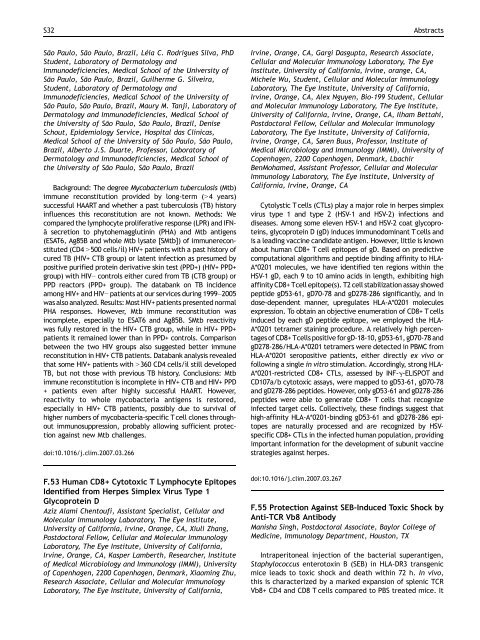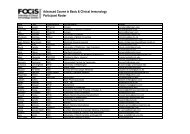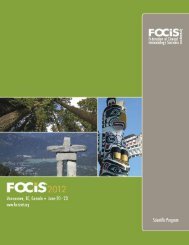Oral Presentations - Federation of Clinical Immunology Societies
Oral Presentations - Federation of Clinical Immunology Societies
Oral Presentations - Federation of Clinical Immunology Societies
You also want an ePaper? Increase the reach of your titles
YUMPU automatically turns print PDFs into web optimized ePapers that Google loves.
S32 Abstracts<br />
São Paulo, São Paulo, Brazil, Léia C. Rodrigues Silva, PhD<br />
Student, Laboratory <strong>of</strong> Dermatology and<br />
Immunodeficiencies, Medical School <strong>of</strong> the University <strong>of</strong><br />
São Paulo, São Paulo, Brazil, Guilherme G. Silveira,<br />
Student, Laboratory <strong>of</strong> Dermatology and<br />
Immunodeficiencies, Medical School <strong>of</strong> the University <strong>of</strong><br />
São Paulo, São Paulo, Brazil, Maury M. Tanji, Laboratory <strong>of</strong><br />
Dermatology and Immunodeficiencies, Medical School <strong>of</strong><br />
the University <strong>of</strong> São Paulo, São Paulo, Brazil, Denise<br />
Schout, Epidemiology Service, Hospital das Clínicas,<br />
Medical School <strong>of</strong> the University <strong>of</strong> São Paulo, São Paulo,<br />
Brazil, Alberto J.S. Duarte, Pr<strong>of</strong>essor, Laboratory <strong>of</strong><br />
Dermatology and Immunodeficiencies, Medical School <strong>of</strong><br />
the University <strong>of</strong> São Paulo, São Paulo, Brazil<br />
Background: The degree Mycobacterium tuberculosis (Mtb)<br />
immune reconstitution provided by long-term (N4 years)<br />
successful HAART and whether a past tuberculosis (TB) history<br />
influences this reconstitution are not known. Methods: We<br />
compared the lymphocyte proliferative response (LPR) and IFNã<br />
secretion to phytohemagglutinin (PHA) and Mtb antigens<br />
(ESAT6, Ag85B and whole Mtb lysate [SMtb]) <strong>of</strong> immunereconstituted<br />
(CD4 N500 cells/ìl) HIV+ patients with a past history <strong>of</strong><br />
cured TB (HIV+ CTB group) or latent infection as presumed by<br />
positive purified protein derivative skin test (PPD+) (HIV+ PPD+<br />
group) with HIV− controls either cured from TB (CTB group) or<br />
PPD reactors (PPD+ group). The databank on TB incidence<br />
among HIV+ and HIV− patients at our services during 1999–2005<br />
was also analyzed. Results: Most HIV+ patients presented normal<br />
PHA responses. However, Mtb immune reconstitution was<br />
incomplete, especially to ESAT6 and Ag85B. SMtb reactivity<br />
was fully restored in the HIV+ CTB group, while in HIV+ PPD+<br />
patients it remained lower than in PPD+ controls. Comparison<br />
between the two HIV groups also suggested better immune<br />
reconstitution in HIV+ CTB patients. Databank analysis revealed<br />
that some HIV+ patients with N360 CD4 cells/ìl still developed<br />
TB, but not those with previous TB history. Conclusions: Mtb<br />
immune reconstitution is incomplete in HIV+ CTB and HIV+ PPD<br />
+ patients even after highly successful HAART. However,<br />
reactivity to whole mycobacteria antigens is restored,<br />
especially in HIV+ CTB patients, possibly due to survival <strong>of</strong><br />
higher numbers <strong>of</strong> mycobacteria-specific T cell clones throughout<br />
immunosuppression, probably allowing sufficient protection<br />
against new Mtb challenges.<br />
doi:10.1016/j.clim.2007.03.266<br />
F.53 Human CD8+ Cytotoxic T Lymphocyte Epitopes<br />
Identified from Herpes Simplex Virus Type 1<br />
Glycoprotein D<br />
Aziz Alami Chentoufi, Assistant Specialist, Cellular and<br />
Molecular <strong>Immunology</strong> Laboratory, The Eye Institute,<br />
University <strong>of</strong> California, Irvine, Orange, CA, Xiuli Zhang,<br />
Postdoctoral Fellow, Cellular and Molecular <strong>Immunology</strong><br />
Laboratory, The Eye Institute, University <strong>of</strong> California,<br />
Irvine, Orange, CA, Kasper Lamberth, Researcher, Institute<br />
<strong>of</strong> Medical Microbiology and <strong>Immunology</strong> (IMMI), University<br />
<strong>of</strong> Copenhagen, 2200 Copenhagen, Denmark, Xiaoming Zhu,<br />
Research Associate, Cellular and Molecular <strong>Immunology</strong><br />
Laboratory, The Eye Institute, University <strong>of</strong> California,<br />
Irvine, Orange, CA, Gargi Dasgupta, Research Associate,<br />
Cellular and Molecular <strong>Immunology</strong> Laboratory, The Eye<br />
Institute, University <strong>of</strong> California, Irvine, orange, CA,<br />
Michele Wu, Student, Cellular and Molecular <strong>Immunology</strong><br />
Laboratory, The Eye Institute, University <strong>of</strong> California,<br />
Irvine, Orange, CA, Alex Nguyen, Bio-199 Student, Cellular<br />
and Molecular <strong>Immunology</strong> Laboratory, The Eye Institute,<br />
University <strong>of</strong> California, Irvine, Orange, CA, Ilham Bettahi,<br />
Postdoctoral Fellow, Cellular and Molecular <strong>Immunology</strong><br />
Laboratory, The Eye Institute, University <strong>of</strong> California,<br />
Irvine, Orange, CA, Søren Buus, Pr<strong>of</strong>essor, Institute <strong>of</strong><br />
Medical Microbiology and <strong>Immunology</strong> (IMMI), University <strong>of</strong><br />
Copenhagen, 2200 Copenhagen, Denmark, Lbachir<br />
BenMohamed, Assistant Pr<strong>of</strong>essor, Cellular and Molecular<br />
<strong>Immunology</strong> Laboratory, The Eye Institute, University <strong>of</strong><br />
California, Irvine, Orange, CA<br />
Cytolystic T cells (CTLs) play a major role in herpes simplex<br />
virus type 1 and type 2 (HSV-1 and HSV-2) infections and<br />
diseases. Among some eleven HSV-1 and HSV-2 coat glycoproteins,<br />
glycoprotein D (gD) induces immunodominant T cells and<br />
is a leading vaccine candidate antigen. However, little is known<br />
about human CD8+ T cell epitopes <strong>of</strong> gD. Based on predictive<br />
computational algorithms and peptide binding affinity to HLA-<br />
A*0201 molecules, we have identified ten regions within the<br />
HSV-1 gD, each 9 to 10 amino acids in length, exhibiting high<br />
affinity CD8+ Tcell epitope(s). T2 cell stabilization assay showed<br />
peptide gD53-61, gD70-78 and gD278-286 significantly, and in<br />
dose-dependent manner, upregulates HLA-A*0201 molecules<br />
expression.Toobtainanobjectiveenumeration<strong>of</strong>CD8+Tcells<br />
induced by each gD peptide epitope, we employed the HLA-<br />
A*0201 tetramer staining procedure. A relatively high percentages<br />
<strong>of</strong> CD8+ Tcells positive for gD-18-10, gD53-61, gD70-78 and<br />
gD278-286/HLA-A*0201 tetramers were detected in PBMC from<br />
HLA-A*0201 seropositive patients, either directly ex vivo or<br />
following a single in vitro stimulation. Accordingly, strong HLA-<br />
A*0201-restricted CD8+ CTLs, assessed by INF-γ-ELISPOT and<br />
CD107a/b cytotoxic assays, were mapped to gD53-61, gD70-78<br />
and gD278-286 peptides. However, only gD53-61 and gD278-286<br />
peptides were able to generate CD8+ T cells that recognize<br />
infected target cells. Collectively, these findings suggest that<br />
high-affinity HLA-A*0201-binding gD53-61 and gD278-286 epitopes<br />
are naturally processed and are recognized by HSVspecific<br />
CD8+ CTLs in the infected human population, providing<br />
important information for the development <strong>of</strong> subunit vaccine<br />
strategies against herpes.<br />
doi:10.1016/j.clim.2007.03.267<br />
F.55 Protection Against SEB-Induced Toxic Shock by<br />
Anti-TCR Vb8 Antibody<br />
Manisha Singh, Postdoctoral Associate, Baylor College <strong>of</strong><br />
Medicine, <strong>Immunology</strong> Department, Houston, TX<br />
Intraperitoneal injection <strong>of</strong> the bacterial superantigen,<br />
Staphylococcus enterotoxin B (SEB) in HLA-DR3 transgenic<br />
mice leads to toxic shock and death within 72 h. In vivo,<br />
this is characterized by a marked expansion <strong>of</strong> splenic TCR<br />
Vb8+ CD4 and CD8 T cells compared to PBS treated mice. It




